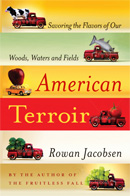Oyster Invitational Challenge–Results
May 15, 2008
On April 7, 2008, at the Westin Hotel in Providence, Rhode Island, twenty all-star virginicas competed for the title of Best Tasting Oyster in a major blind tasting. Many of my favorites, including Moonstones, Watch Hills, Island Creeks, Pemaquids, Katama Bays, Mystics, and Totten Virginicas, threw their hats in the ring. The judges included such bivalve virtuosos as Peter Hoffman of Savoy and Sandy Ingber of Grand Central Oyster Bar. To me, the Totten Virginicas stood out—they had a fruity umami depth rare in Atlantic oysters—but they came in second, beaten out by Island Creeks, whose crisp, zesty brine was apparent even in April, a tough month for northeast oysters. Third place was a tie between Ninigret Cups (Charlestown, RI) and Sweet Petites (Katama Bay, Martha’s Vineyard).
This was the most extensive blind tasting I’d participated in, so I was excited to examine my score sheets once the blindfold was off and learn whether they were in keeping with my observations in the book. They were, and also were in agreement (mostly) with the other judges. There seems to be some general consensus about what makes a great oyster, and which oysters those are. But there also were some real surprises, and one case where I think my fellow judges were out to lunch (or maybe I am). Here’s what I know:
Totten Virginicas rule. Picture the difference between a homemade fish stock and canned broth. That extra depth is the difference between the Tottens and everything else I tasted. They were the only oyster I gave a perfect 10.
Three oysters got 8s: Island Creeks, Sweet Petites, and Moonstones. On Sweet Petites I wrote “Salty, but excellent,” and on Island Creeks I wrote “Great with beer.” That’s in keeping with my earlier impressions of these oysters: They are delicious, but very, very briny, great with a cold one to wash away the salt. On Moonstones I wrote “Classic,” and I still think of Moonstones as THE classic virginica. They were my second-favorite, after the Tottens, and one of only three oysters that I gave a perfect score for sweetness. (The others were Tottens and Ninigret Cups.) But hold on: Moonstones finished in the middle of the pack overall, a distant 8th. This shocked me at the time, and now that I’ve seen my sheet, I’m even more surprised. Did I get some particularly good ones, or was that mineral flavor I’ve always loved in Moonstones off-putting to the other judges?
One thing worth noting about Sweet Petites is that they’re grown in Katama Bay, on Martha’s Vineyard, and that there was a second Katama Bay oyster in the judging that received low marks. Sweet Petites are often sold as Katama Bays, so anytime you see Katama Bays listed, check to make sure they’re the Sweet Petites farmed by Jack Blake.
Ninigret Cups are an interesting case. They came in third overall, but I had them in a middle tier along with Pemaquids, Cape May Salts, Snow Hills, and New Points. The Ninigrets were wonderfully sweet, but they lost points with me because of a slight boiled potato aroma. I was surprised the Pemaquids didn’t fare better, since I’ve loved them in the past, but I think early April is a very tough time for Maine oysters, and I’d expect Pemaquids to be right back on top of the heap at any fall tasting. The Cape May Salts were the most unusual oysters in the tasting. They were strongly peppery. I mean really peppery—they made your lips tingle. I don’t know if this is a good thing or not (and it makes me wonder about Delaware), but they were nice oysters.
One final observation. Since my book came out, I’ve caught a fair amount of flak from southern oyster growers who feel that their oysters get no respect. This Invitational Challenge included oysters from Louisiana, Apalachicola, and South Carolina, so I looked forward to trying them all with no cultural blinders on. Alas, they were terrible. I wrote comments on my sheets like “yuck” and “the worst.” They all lost points for “Wet Dog” odors and mushy, flaccid meat. Some of the odors were worse than wet dog; I won’t even go into it. They were bad oysters, and they reinforced all my previous impressions. The South makes some great foods. Tupelo honey, peaches, citrus. But oysters is not one of them.
It reminds me of an experience I had at the Boston Seafood Show in February. I passed a Florida Seafood booth, and the man there told me he’d read my book and that I really hadn’t been fair to Apalachicola oysters, which were the best in the world. He handed me one to prove it. “Maybe he’s right,” I thought. “Maybe I haven’t been fair.” So I slid the oyster in my mouth and bit down—on a tasteless oyster that was still frozen in the middle. I might have been traumatized for a long time had I not been able to swing around the corner to the next aisle and revive my palate with a pile of crisp, glorious, ultra-fresh Island Creeks.
« PREVIOUS: Katama Bays
» NEXT: James Beard Award
 Recent Posts
Recent Posts
